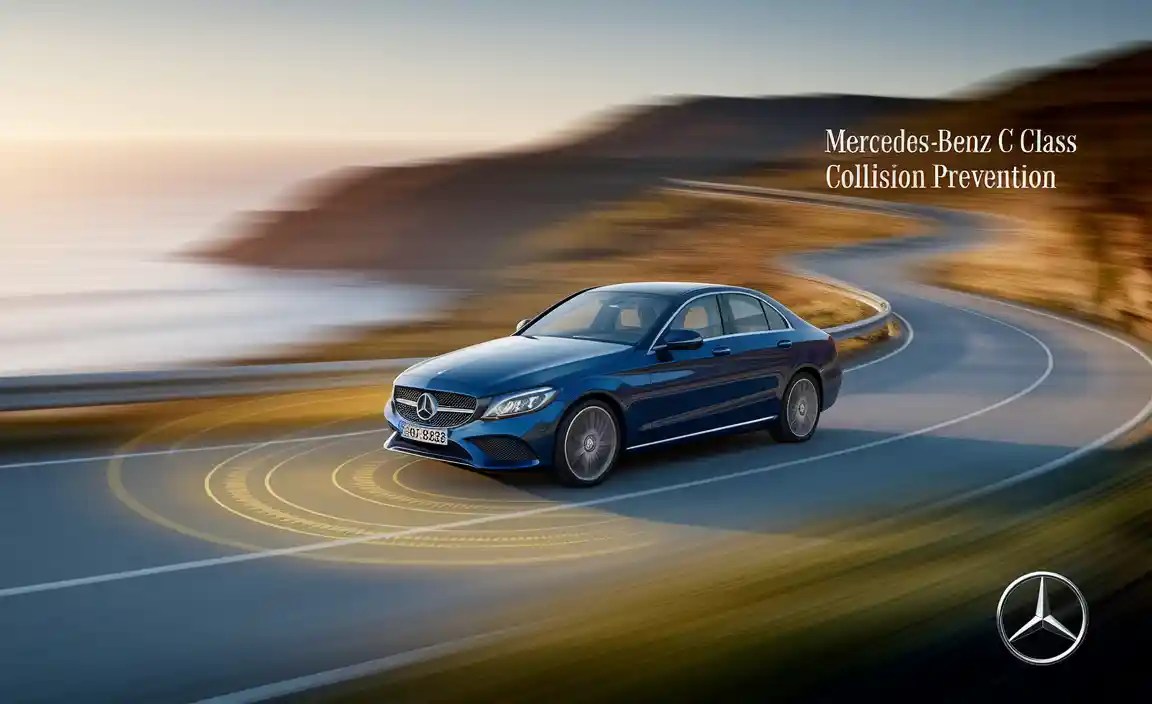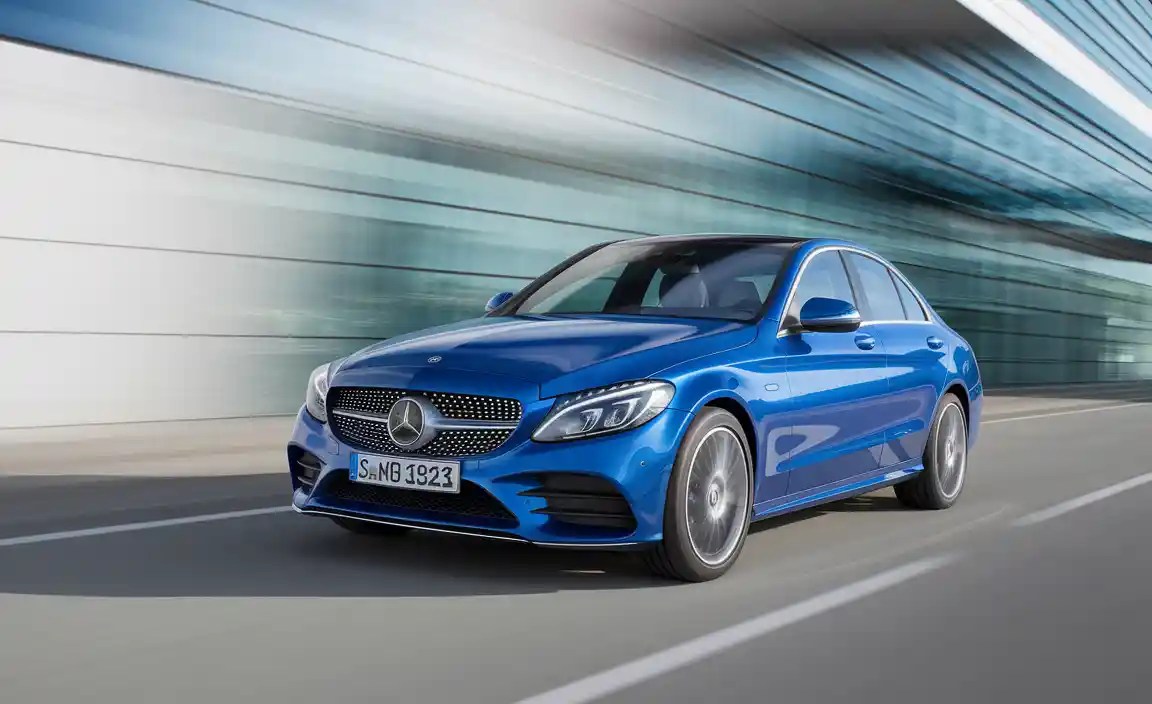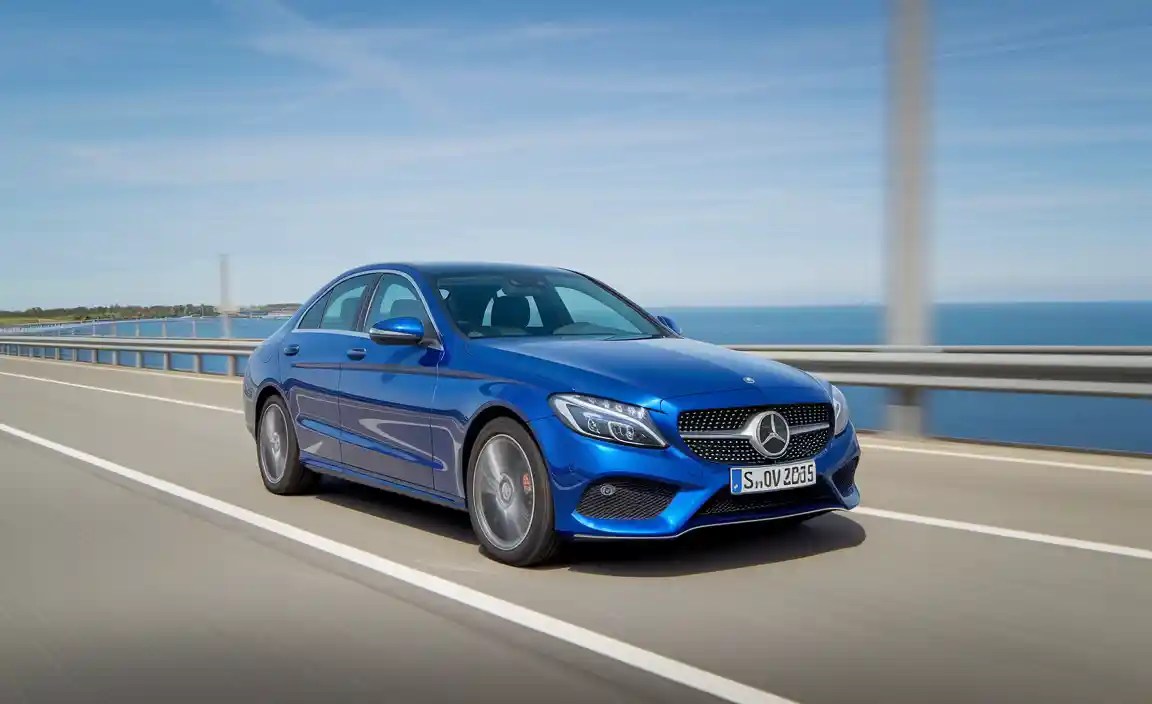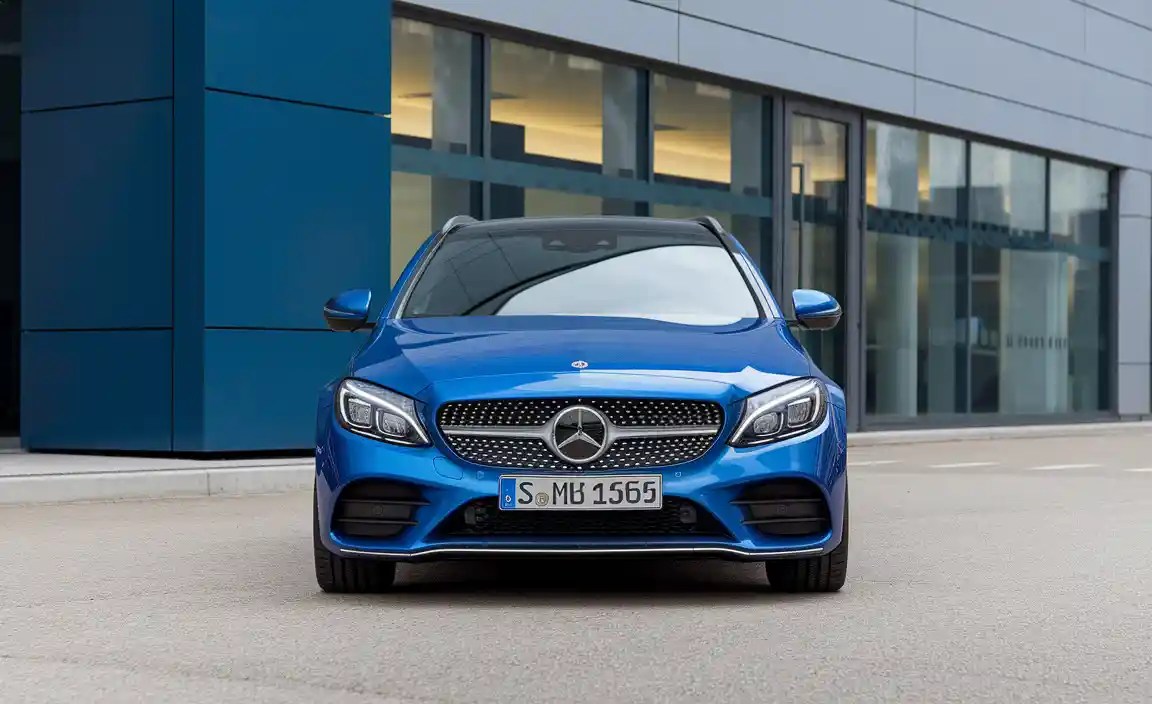Mercedes-Benz C Class Collision Prevention: Ultimate Safety
Optimize your Mercedes-Benz C-Class for ultimate safety with advanced collision prevention systems. Learn how these intelligent technologies work to detect potential hazards and assist in avoiding or mitigating accidents, keeping you and your passengers secure on every journey.
Navigating the road in your Mercedes-Benz C-Class should feel like an extension of comfort and control. Yet, the unexpected can always happen. Understanding and utilizing your C-Class’s advanced collision prevention features is like having an extra set of eyes, offering a crucial layer of security.
These sophisticated systems aren’t just about luxury; they are engineered to proactively safeguard you. This guide will demystify these technologies, explaining how they function and how you can ensure they’re working at their best, so you can drive with unparalleled confidence.

Understanding C-Class Collision Prevention: Your Digital Guardian
Mercedes-Benz has long been a pioneer in automotive safety, and the C-Class is a prime example of this commitment. Collision prevention systems in the C-Class are designed to work in concert, acting as a vigilant co-pilot. They aim to prevent accidents before they occur or, at the very least, reduce their severity. These systems leverage a combination of radar, cameras, and sensors to constantly monitor the vehicle’s surroundings.

At its core, collision prevention in the C-Class is about awareness and intervention. The car “sees” what’s happening around it and, when necessary, alerts the driver or even takes action to avoid a potential collision. This proactive approach significantly enhances driving safety, especially in busy urban environments or during long highway drives where fatigue can set in.
Key Collision Prevention Technologies in the C-Class
The C-Class often comes equipped with a suite of advanced driver-assistance systems (ADAS) designed to enhance safety. While specific features can vary by model year and optional packages, here are some of the most common and impactful collision prevention technologies found in the C-Class:
- Active Brake Assist (ABA): This is a cornerstone of Mercedes-Benz’s safety technology. It can detect oncoming traffic, cross-traffic, pedestrians, and other vehicles. If it senses a high risk of a collision, it will first provide a visual and audible warning. If the driver doesn’t react, the system can automatically apply the brakes to help avoid or mitigate the impact.
- ATTENTION ASSIST®: This system monitors steering input and other parameters to detect signs of driver fatigue. If it detects drowsiness, it will issue a visual and audible warning, suggesting the driver take a break.
- Active Lane Keeping Assist (ALKA): If the vehicle unintentionally drifts out of its lane, ALKA can detect this and apply gentle braking to one side of the car to steer it back into its lane. It works by monitoring lane markings.
- Active Blind Spot Assist (ABSA): This system monitors the blind spots on either side of the vehicle. If it detects a vehicle in the blind spot when you signal to change lanes, it will provide a visual warning in the side mirror and a warning chime. In critical situations, it can also actively brake to help prevent a lane-change collision.
- DISTRONIC PLUS® with Steering Assist: This intelligent cruise control system can maintain a set speed and distance from the vehicle ahead. The added Steering Assist function can help keep the C-Class centered in its lane by providing gentle steering intervention, effectively reducing driver fatigue on highways.
- PRE-SAFE® System: This is a comprehensive safety concept that can detect potential accident situations and initiate preventative measures. This includes tightening seatbelts, closing windows and sunroof, and repositioning seats to better protect occupants in the event of a crash.
- Cross-Traffic Alert (for ABA): A function within Active Brake Assist that detects approaching traffic when you are reversing out of a parking space or driveway. It provides warnings and can automatically apply brakes if a collision is imminent.
How C-Class Collision Prevention Systems Work: The Technology Behind the Safety
The magic of collision prevention lies in the seamless integration of sophisticated sensors, cameras, and intelligent software. Each component plays a vital role in creating a comprehensive safety net around your C-Class.

Sensors and Cameras: The Eyes and Ears of Your C-Class
Your C-Class is equipped with an array of sensors and cameras strategically placed around the vehicle:
- Radar Sensors: Typically located in the front and rear bumpers, these sensors emit radio waves and measure the time it takes for them to bounce back. This allows them to determine the distance, speed, and direction of other vehicles and objects.
- Cameras: A multi-purpose camera, often located behind the windshield near the rearview mirror, recognizes lane markings, traffic signs, pedestrians, and other vehicles. Various other cameras around the vehicle provide a 360-degree view for systems like parking assist.
- Ultrasonic Sensors: These sensors emit sound waves and measure their reflection to detect objects at close range, primarily used for parking and low-speed maneuvers.
The Brains of the Operation: How Data is Processed
All the data collected by these sensors and cameras is fed into the C-Class’s central computer systems. This “brain” continuously analyzes the incoming information in real-time. Using complex algorithms, it:
- Identifies Potential Hazards: The system distinguishes between stationary objects, moving vehicles, pedestrians, and cyclists.
- Calculates Collision Risk: It assesses the likelihood and severity of a potential collision based on speed, distance, and trajectory.
- Determines Necessary Action: Based on the risk assessment, the system decides whether to warn the driver, intervene with braking, or provide steering assistance.
Driver Alerts and Interventions
When a potential hazard is detected, the C-Class employs multiple methods to alert the driver and assist in avoiding a collision:
- Visual Warnings: Icons or messages might appear on the instrument cluster or head-up display.
- Audible Warnings: Chimes or warning sounds will alert the driver.
- Haptic Feedback: In some systems, the steering wheel might vibrate briefly.
- Brake Interventions: If the driver doesn’t respond to warnings, the system can apply partial or full braking force.
- Steering Interventions: Systems like Steering Assist can make subtle adjustments to the steering wheel to help keep the vehicle in its lane or avoid obstacles.
Maximizing C-Class Collision Prevention: Essential Best Practices
Your C-Class’s safety systems are incredibly advanced, but they work best when drivers are aware of their capabilities and limitations and maintain them properly. Here’s how to ensure you’re getting the most out of your collision prevention suite:

Driver Awareness is Key
Even with advanced technology, the driver remains the primary safety component.
- Understand Your Systems: Familiarize yourself with the specific collision prevention features available in your C-Class model. Read your owner’s manual to understand how each system works, its limitations, and how to activate or deactivate them if necessary.
- Don’t Over-Rely: These systems are aids, not replacements for attentive driving. Always maintain a safe following distance, be aware of your surroundings, and be prepared to take manual control at any moment.
- Stay Focused: Avoid distractions like mobile phones or complex infotainment system adjustments while driving.
- Respect Speed Limits: Higher speeds reduce the effectiveness of braking systems and the time available to react.
Maintaining Your C-Class Safety Systems
Proper maintenance ensures your collision prevention systems function as intended.
- Keep Sensors and Cameras Clean: The radar sensors (often behind bumper covers) and cameras (usually behind the windshield) need to be unobstructed. Dirt, snow, ice, mud, or even excessive bug splatters can impair their performance. Regularly clean these areas with a soft cloth and mild automotive cleaner.
- Windshield Integrity: A cracked or significantly damaged windshield can interfere with the view of the forward-facing camera, potentially disabling or reducing the effectiveness of systems like Active Brake Assist and Lane Keeping Assist. Get any windshield damage repaired or replaced promptly by a qualified professional.
- Proper Wheel Alignment: While seemingly unrelated, poor wheel alignment can affect steering inputs and sensor calibration, potentially impacting systems that rely on precise vehicle position, like Lane Keeping Assist. Ensure your alignment is checked periodically.
- Tire Condition and Pressure: Properly inflated tires with good tread depth are crucial for vehicle stability and braking performance, which indirectly supports the effectiveness of collision avoidance systems.
- Regular Servicing: Adhere to your Mercedes-Benz scheduled maintenance intervals. Technicians will often perform diagnostic checks on these systems to ensure they are functioning correctly.
Understanding System Limitations
It’s crucial to know that even the most advanced technology has its limits.
- Weather Conditions: Heavy rain, fog, snow, or direct sunlight can sometimes affect the performance of cameras and radar sensors.
- Complex Environments: In extremely crowded or chaotic traffic situations, or with unusual road designs, the systems might become confused or less effective.
- Unusual Obstacles: The systems are designed to detect common road hazards. Less common objects or debris might not be recognized.
- Driver Input: The systems are designed to assist, not to override a determined driver. If you are actively steering away from something, the assistance systems might adapt or disengage.
C-Class Collision Prevention System Performance: A Comparative Look
While all C-Class models benefit from Mercedes-Benz’s commitment to safety, the specific suite of collision prevention technologies can vary slightly depending on the generation, model year, and optional packages selected. Here’s a general overview of how these systems are integrated:

| System Name | Primary Function | Typical Scenario | Key Components | Availability (General) |
|---|---|---|---|---|
| Active Brake Assist (ABA) | Detects and brakes for vehicles, pedestrians, cross-traffic. | Frontal collision avoidance, intersection turns, braking traffic. | Radar, Camera | Standard or optional on most C-Class models; enhanced versions in higher trims/packages. |
| ATTENTION ASSIST® | Monitors driver for fatigue. | Long highway drives, monotonous conditions. | Steering sensor, vehicle dynamics analysis. | Standard on most C-Class models. |
| Active Lane Keeping Assist (ALKA) | Steers vehicle back into lane if drifting. | Unintentional lane departure. | Camera, Steering system. | Optional or part of Driving Assistance Package. |
| Active Blind Spot Assist (ABSA) | Warns of and brakes to prevent lane change collisions. | Lane changes with vehicles in blind spot. | Radar, Brake system. | Optional or part of Driving Assistance Package. |
| DISTRONIC PLUS® with Steering Assist | Adaptive cruise control with lane centering. | Highway driving, stop-and-go traffic. | Radar, Camera, Steering system. | Optional, part of higher-tier Driving Assistance Packages. |
| PRE-SAFE® System | Pre-collision occupant protection. | Imminent crash detection. | Sensors detecting potential impact, seatbelt tensioners, window/sunroof closure. | Standard on most C-Class models. |
For the most accurate information regarding the specific collision prevention systems available on a particular C-Class model, it is always recommended to consult the vehicle’s window sticker, owner’s manual, or the official Mercedes-Benz configurator for the relevant model year.
External Resources for Enhanced Safety Understanding
To further deepen your understanding of automotive safety technologies and their impact, consider these authoritative resources:
- National Highway Traffic Safety Administration (NHTSA): NHTSA provides extensive information on vehicle safety, including ratings, recall alerts, and explanations of advanced safety features. You can explore their resources at nhtsa.gov.
- Insurance Institute for Highway Safety (IIHS): The IIHS conducts independent safety testing and research on vehicles, offering detailed reports on crashworthiness and the effectiveness of crash avoidance technologies. Visit them at iihs.org.
Conclusion: Drive with Unwavering Confidence in Your C-Class
Your Mercedes-Benz C-Class is more than just a car; it’s a meticulously engineered sanctuary designed for your safety and comfort. The advanced collision prevention technologies are at the forefront of this commitment, acting as vigilant guardians on every drive. By understanding how these systems work, maintaining them diligently, and always driving attentively, you unlock the full potential of your C-Class’s safety design.
From the subtle warnings of ATTENTION ASSIST® to the crucial interventions of Active Brake Assist, these intelligent features work tirelessly to keep you and your loved ones protected. Embrace the peace of mind that comes with knowing your vehicle is equipped with the ultimate in automotive safety. Drive smart, drive safe, and enjoy the unparalleled confidence that only a Mercedes-Benz can provide.
FAQs:
What is the most important collision prevention feature in my C-Class?
While all features contribute to safety, Active Brake Assist is arguably one of the most critical as it directly intervenes to prevent or mitigate a collision by applying the brakes automatically. However, the importance of each system can depend on your driving habits and environments.
Can I turn off my C-Class collision prevention systems?
Yes, most collision prevention systems in the C-Class can be deactivated or adjusted via the vehicle’s infotainment system or dedicated buttons on the steering wheel or center console. The owner’s manual will provide specific instructions for your model. However, it’s generally not recommended to disable them unless absolutely necessary.
How do I know if my C-Class collision prevention systems are working?
When you start your car, many systems perform a self-check, and associated warning lights on the dashboard will typically illuminate and then turn off. When a system activates (e.g., a warning from Active Brake Assist), you will usually receive a visual and/or audible alert. If a system is malfunctioning, a specific warning light will illuminate on your dashboard.
Will my C-Class collision prevention work in heavy rain or fog?
These systems are designed to be robust, but severe weather conditions like heavy rain, fog, snow, or even direct, low-angle sunlight can sometimes degrade sensor performance. The vehicle’s display may indicate when a system’s functionality is limited due to environmental conditions.
Are collision prevention systems included in all C-Class models?
Basic safety features like ATTENTION ASSIST® are often standard. More advanced systems like Active Brake Assist, DISTRONIC PLUS®, Active Lane Keeping Assist, and Active Blind Spot Assist are frequently part of optional “Driving Assistance Packages” or higher trim levels. Check the specific configuration of your C-Class.
What happens if a sensor on my C-Class is blocked?
If a sensor or camera is blocked (e.g., by dirt, snow, or ice), the system that relies on it will typically become unavailable. The car’s dashboard will usually display a message indicating that the system is temporarily inactive or that the sensors need cleaning/checking.
How often should my C-Class collision prevention systems be serviced?
Beyond regular maintenance checks performed by a Mercedes-Benz dealership during scheduled service appointments, there isn’t a specific interval for servicing these individual systems. However, if you notice any warning lights or suspect a malfunction, it’s crucial to have them inspected by a qualified technician promptly.






